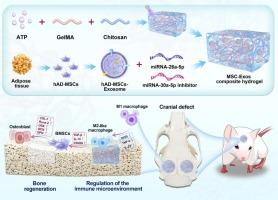通过免疫微环境调节,构建装载microrna的msc外泌体支架促进成骨
IF 13.2
1区 工程技术
Q1 ENGINEERING, CHEMICAL
引用次数: 0
摘要
免疫微环境在骨愈合中起关键作用,巨噬细胞极化显著影响组织修复结果。本研究的重点是构建一种水凝胶支架,该支架富集了携带microRNAs (MSC-Exos+miRNA)的人脂肪源性间充质干细胞(hAD-MSCs)的外泌体。目的是通过将巨噬细胞从炎性M1表型转移到再生M2表型来增强骨形成。这种免疫调节旨在为骨髓干细胞(BMSCs)的成骨分化创造一个支持性的环境。结果表明,MSC-Exos+miRNA支架在体外和体内均能显著增强成骨标志物的表达,促进细胞外基质矿化。组织学分析显示,MSC-Exos+miRNA组成熟骨形成,胶原沉积。这些发现强调了支架作为骨组织工程(BTE)有效工具的潜力,为推进骨修复和再生提供了有希望的方法。本文章由计算机程序翻译,如有差异,请以英文原文为准。

Construction of microRNA-loaded MSC-exosomes scaffold for promoting osteogenesis through immune microenvironment modulation
The immune microenvironment plays a critical role in bone healing, with macrophage polarization significantly influencing tissue repair outcomes. This study focused on creating a hydrogel scaffold enriched with exosomes from human adipose-derived mesenchymal stem cells (hAD-MSCs) carrying microRNAs (MSC-Exos+miRNA). The aim was to enhance bone formation by shifting macrophages from the inflammatory M1 phenotype to the regenerative M2 phenotype. This immune modulation was intended to create a supportive environment for the osteogenic differentiation of bone marrow stem cells (BMSCs). The results showed that the MSC-Exos+miRNA scaffold markedly enhanced the expression of osteogenic markers and promoted extracellular matrix mineralization both in vitro and in vivo. Histological analysis indicated the formation of mature bone and collagen deposition in the MSC-Exos+miRNA group. These findings underscore the scaffold's potential as an effective tool for bone tissue engineering (BTE), providing promising approaches for advancing bone repair and regeneration.
求助全文
通过发布文献求助,成功后即可免费获取论文全文。
去求助
来源期刊

Chemical Engineering Journal
工程技术-工程:化工
CiteScore
21.70
自引率
9.30%
发文量
6781
审稿时长
2.4 months
期刊介绍:
The Chemical Engineering Journal is an international research journal that invites contributions of original and novel fundamental research. It aims to provide an international platform for presenting original fundamental research, interpretative reviews, and discussions on new developments in chemical engineering. The journal welcomes papers that describe novel theory and its practical application, as well as those that demonstrate the transfer of techniques from other disciplines. It also welcomes reports on carefully conducted experimental work that is soundly interpreted. The main focus of the journal is on original and rigorous research results that have broad significance. The Catalysis section within the Chemical Engineering Journal focuses specifically on Experimental and Theoretical studies in the fields of heterogeneous catalysis, molecular catalysis, and biocatalysis. These studies have industrial impact on various sectors such as chemicals, energy, materials, foods, healthcare, and environmental protection.
 求助内容:
求助内容: 应助结果提醒方式:
应助结果提醒方式:


